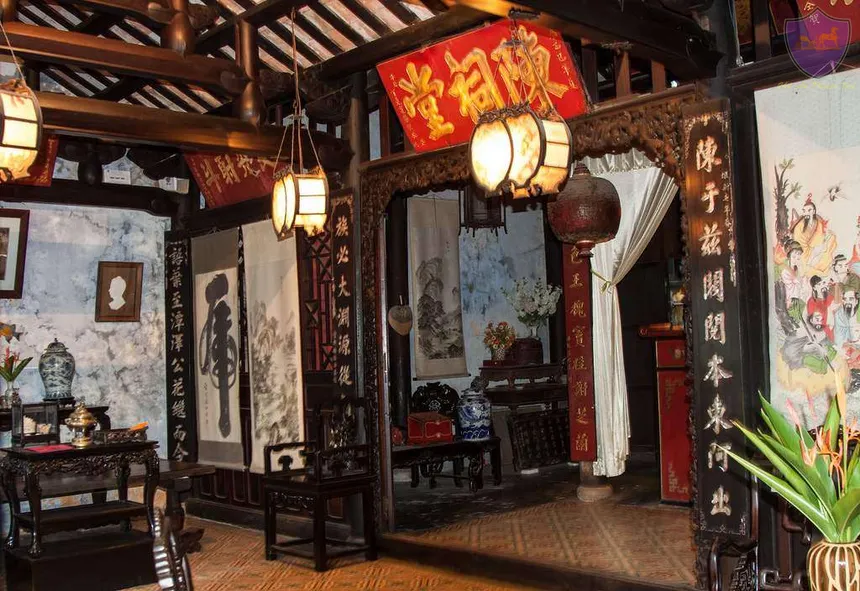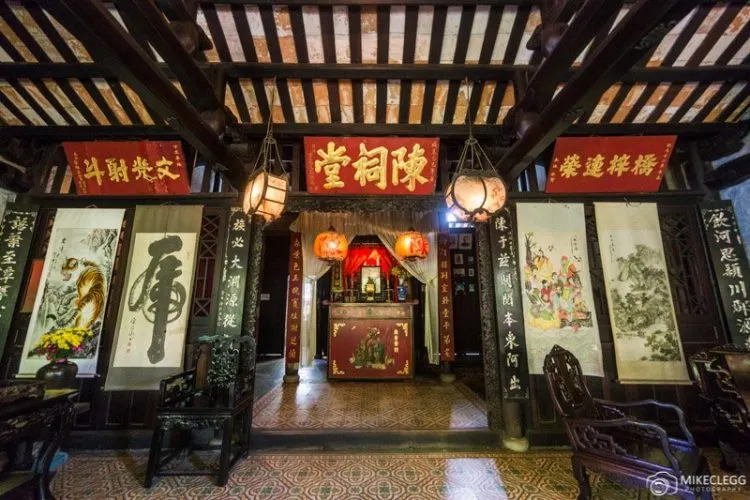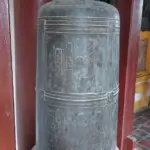Visiting Tran Family Chapel: Location, Access, and Opening Hours by Ovuigo
The Tran Family Chapel, a rare gem encapsulating the essence of Vietnamese familial tradition, sits quietly in the historic stretch of Hoi An ancient town. Though often referred to as Tran Family Chapel Da Nang due to its geographical proximity, its precise location is 21 Lê Lợi, Phường Minh An, Hội An, Quảng Nam. Find it here on Google Maps. This locale situates the ancestral house within a short walk from Hoi An’s main attractions—perfect for those exploring Vietnam’s cultural heart.
Access to the Tran Family Chapel is simple. Arrival by bicycle, on foot, or bicycle taxi is common, thanks to Hoi An’s vehicle-free town center. Visitors looking for step-by-step instructions should begin at the Japanese Bridge—a famous Hoi An landmark—and head south along Lê Lợi Street. Signs mark this historic site. The chapel is open from 7:00 AM to 6:00 PM on weekdays and until 9:00 PM on weekends. The ticket price for visiting the Tran Family Chapel as part of Hoi An’s composite old town ticket is approximately 120,000 VND (about $5 USD). This ticket covers many heritage buildings within Hoi An ancient town, making it practical for history enthusiasts.
The site is accessible for most visitors, but those with mobility issues should be aware of some steps and narrow entrances due to its original 19th-century structure. Guided tours, including those arranged via ovuigo, are recommended for a deeper exploration, ensuring details about this family shrine and its lasting legacy are not missed.

Historical Background of Tran Family Chapel
Constructed in the early 1800s, Tran Family Chapel stands as one of the oldest and most revered private heritage buildings in all of Hoi An ancient town. Its establishment by the Trần family marks an era of Vietnamese society where family lineage and ancestral worship played central roles. As skilled traders and officials often serving under the Nguyễn dynasty, the Tran family became eminent, and the chapel became the heart of their family’s spiritual and cultural life. This family shrine was both a residential space and a sacred place.
The Tran Family Chapel’s story is intertwined with the broader context of Vietnamese history. During the 19th century, the region prospered, and ancient town Hoi An thrived as a commercial port. The chapel not only sheltered family members but also functioned as a center for decision-making, offering, and worship rituals. Today, it embodies the resilience and values of the Trần family amidst the shifting tides of politics and culture across generations.
Unique manuscripts, original calligraphy plaques, and tablets preserved within the ancestral house reflect its vital role in both religion and education. The Nguyen dynasty’s influence is evident in the genealogy records—meticulously stored and still referenced by family elders today. This dedication to tradition explains why the Tran Family Chapel continues to attract both scholars and culture-seekers alike.

Architectural Features and Unique Characteristics
Tran Family Chapel’s architecture is distinctly Vietnamese, fusing traditional lines with the unique tastes of the Trần family. Upon entering, visitors notice the original wooden doors, notable for meticulous carvings and dragon motifs. These doors, rare survivors of time, symbolize family resilience and protection. The tiled roof—a hallmark of Hoi An architecture—curves gently, reminiscent of ancient pagodas.
The central ancestral altar is at the heart of the chapel. Here, golden urns and porcelain incense burners stand alongside ancestral tablets inscribed with calligraphy. The family crest sits above, a symbol of continuity and pride. The chapel’s design follows a harmonious yin-yang layout, creating a tranquil space for both worship and family congregation.
Artifacts dating back to the 19th century include rare manuscripts, ancient family genealogy, and antique furnishings, all of which remain largely untouched thanks to careful preservation. The fusion of Chinese, Japanese, and indigenous Vietnamese styles is evident throughout, illustrating Hoi An’s rich history as a trading port.
Original features—like ancient timber beams and intricately painted eaves—add to the structure’s authenticity. Preservation efforts ensure that each feature, from hidden manuscripts to the dragon-adorned beams, remains a testimony to the Tran family’s lasting influence in Vietnamese culture.

Cultural Significance: Ancestral Worship and Heritage Preservation
As a living example of cultural relics in Vietnam, the Tran Family Chapel continues to play a vital role in ancestral worship—a practice deeply entrenched in Vietnamese culture. Ancestral worship is the cornerstone of the Tran family’s tradition. Here, family members gather for rituals that honor their lineage, remembering the deceased with offerings at the ancestral altar. These rituals, performed regularly, maintain a bridge between generations, keeping inherited values alive.
The importance of family lineage is strongly highlighted by meticulous documentation found in the chapel: ancient family trees, calligraphy plaques, and ancestral tablets. Each symbol, from the incense burner to the crest, reflects the cultural continuity so revered in Vietnamese heritage.
The Tran Family Chapel actively contributes to heritage preservation in Hoi An and Vietnam at large. Family elders take pride in passing traditional practices to younger generations, ensuring unique family rituals are neither forgotten nor commercialized. This ongoing dedication makes the chapel not only a tourist attraction but also a living testament to resilience, respect, and unity within the Vietnamese context.

Tourism Experience and Nearby Attractions in Da Nang and Hoi An
Visitors to Tran Family Chapel can expect a welcoming yet respectful tourism experience. Guided tours—bookable through platforms such as ovuigo.com—are often led by descendants, who share stories, explain spiritual significance, and highlight original artifacts not typically seen elsewhere. Photography is permitted, but visitors should remain quiet and avoid touching sacred objects. The chapel’s setting provides an authentic look into Vietnam’s hidden heritage sites.
Hoi An attractions nearby make any visit richer. Notable sites include the Phung Hung Old House and Tan Ky House, both as historic and meticulously preserved as the Tran Family Chapel. The Japanese Bridge, an iconic Hoi An structure, is just a stone’s throw away and should not be missed for its historic architecture and scenic views. Tickets for these sites are included in the Hoi An ancient town ticket. Consider a combined tour to maximize your exposure to Hoi An’s cultural and architectural marvels.
Restaurants, local shops, and cafes surround the area, providing opportunities to try Vietnamese delicacies. Accommodation options near the chapel range from boutique hotels to resorts like Bliss Hoi An Beach Resort, making it easy to decide where to stay in Hoi An for quick access to heritage sites.

Current Preservation Status and Future of the Tran Family Chapel
The Tran Family Chapel is in a remarkable state of preservation, thanks to the painstaking care provided by both the descendants and local conservation efforts. Restoration techniques prioritize traditional Vietnamese methods—like using natural pigments for painting and employing skilled carpenters for woodwork. Periodic maintenance checks focus on preventing termite damage, water leakage, and preservation of delicate manuscripts.
The family continues to take an active role in stewardship. Many challenges exist: balancing tourism with respect for ritual practices, managing crowd flow to minimize visitor impact, and ensuring funding for ongoing repairs. Partnerships with local heritage authorities help the chapel maintain its heritage status as a cultural relic and valuable Da Nang landmark.
Commitment to future preservation includes education programs, collaborative events for cultural exchange, and digital archiving of historical records. As more travelers seek genuine interactions with Vietnam cultural sites, the chapel stands poised to serve as both a tourist attraction and a symbol of perseverance in Hoi An cultural heritage.
For a detailed cultural experience or to arrange a guided tour, contact us via WhatsApp at +84868319161. Let ovuigo.com make your journey to Da Nang and Hoi An seamless and insightful.
Ready to plan your adventure in Hoi An? Check accommodation options at The Manor Hoi An, Hola 1, and Hola 2—perfect stays within steps of Vietnam’s most treasured heritage sites.




